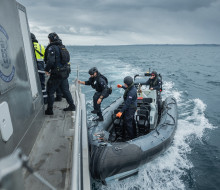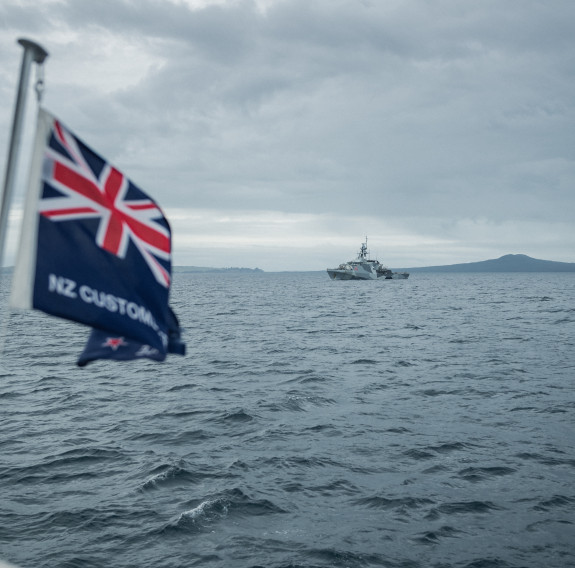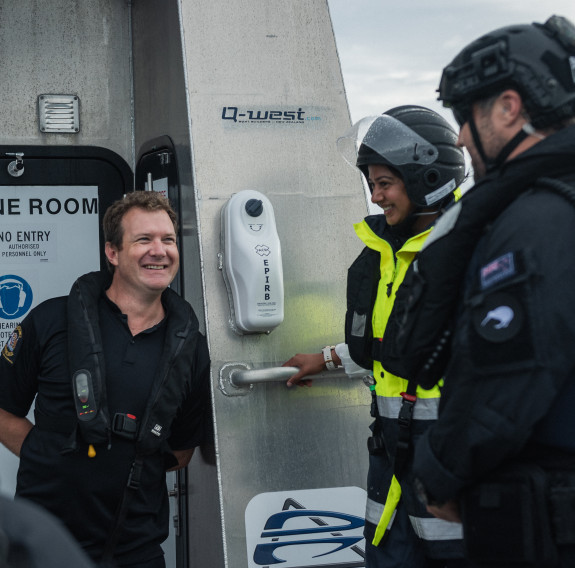
Navy provides boarding expertise for Britain's fishery patrols
19 March 2024
Unfortunately you are viewing this website on an outdated browser which does not support the necessary features for us to provide an adequate experience. Please switch to a modern browser such as latest version of Google Chrome, Mozilla Firefox, Apple Safari or Microsoft Edge.
Ngā mihi nui
The Royal New Zealand Navy is providing a bespoke boarding capability to support Royal Navy fishery patrols in Fiji.
River-class Offshore Patrol Vessel HMS Tamar arrived in New Zealand last month to train with HMNZS Matataua’s Deployable Boarding Team in the Hauraki Gulf, in preparation for fisheries patrols in Fiji.
Tamar and sister ship HMS Spey maintain a roving Royal Navy presence in the Indo-Pacific.
Working from Tamar, the Deployable Boarding Team accompanied Ministry for Primary Industries Fishery Officers in boarding and searching Vessels of Interest, with NZ Customs vessel Hawk V and HMNZS Canterbury posing as vessels with potentially ‘illegal’ fishing hauls.
The scenarios were planned, overseen and assessed by the Navy’s evaluation team, the Maritime Training Group and the Royal Navy equivalent, the Fleet Operational Safety Training team (FOST), who were able to fly to New Zealand to partner the assessment.
Tamar is proceeding to Fiji with the Deployable Boarding Team and a Fishery Officer on board to conduct joint fisheries patrols around Fiji’s islands, helping the nation build up their capacity to curb illegal fishing.

River-class Offshore Patrol Vessel HMS Tamar from NZ Customs vessel Hawk V in the Hauraki Gulf.

The Deployable Boarding Team working with Ministry for Primary Industries Fishery Officers and New Zealand Customs staff.

The Deployable Boarding team in a RHIB, preparing to board a vessel of interest during a training exercise.
Matataua’s Deployable Boarding Teams were stood up last year as a specialist capability, providing a ready-to-go ‘fly-in, fly out’ team capable of supporting a Royal New Zealand Navy ship on operation or the vessels of partner nations.
Commanding Officer Maritime Training Group, Commander Andrew Dowling, says it was good to work with the FOST as both countries had similar systems.
“This kind of engagement opens up opportunities to work together in future and creates possibilities of exchanges between our two navies. It confirms each countries’ standard operating procedures and ways of doing things. Each of us can learn and adapt useful practices from the other. Overall, both units were very much on the same page.”
Commander Thomas Gell, Tamar’s Commanding Officer, says working with the Royal New Zealand Navy is like working with colleagues.
“The training we executed in the Hauraki Gulf with the RNZN Deployable Boarding Team and the RNZN Maritime Training Group has been outstanding.”
“It has also been fantastic to see the Royal Navy’s FOST organisation and the Maritime Training Group come together to deliver world-class training. Tamar and her ship’s company have really benefitted.
“Overall the welcome and support we have received from our RNZN brothers and sisters has been awesome. The partnership between our two navies continues to flourish.”